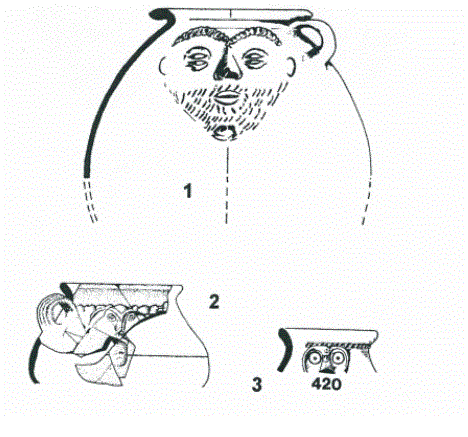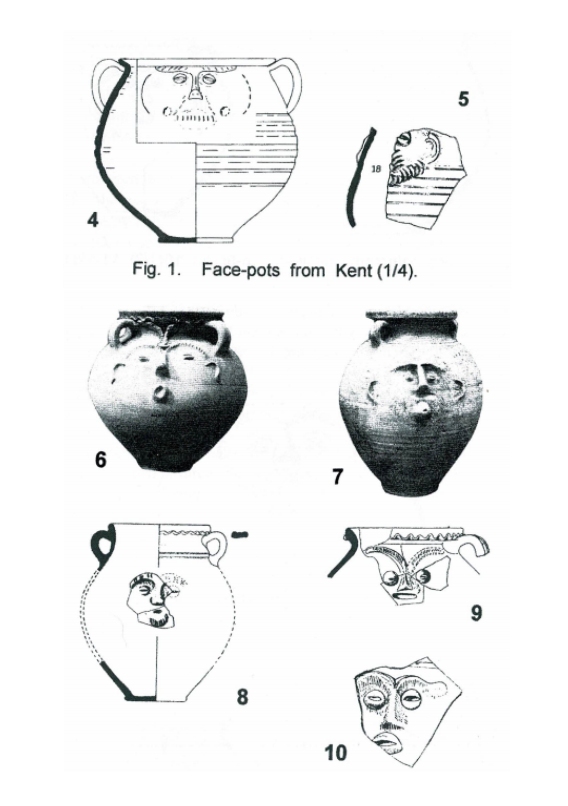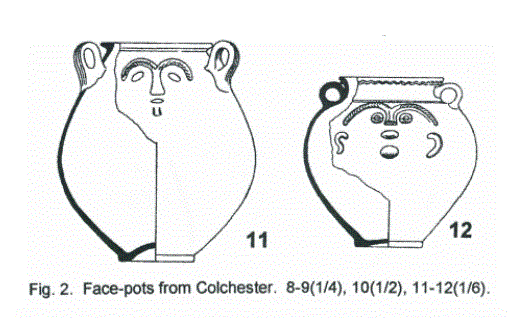FACE-POTS FROM DOVER (COVER PICTURE), KENT AND COLCHESTER
GERALD B CLEWLEY
This important vessel has not previously been published. It was found on the Burial Ground site in Dover in 1970 (Fig. 1, No.2). It is a face-jar with out-curved rim of very fine red-orange ware and with applied moulded features and a grooved handle, probably one of three. The exterior of the vessel has a grey slip and the interior a orange-buff slip. The face has arched eyebrows, stylised squinted eyes, plain nose and a pouted mouth as though he was whistling. Other types of face-pots have been found widely distributed throughout Roman Britain and especially Europe from the first to the fourth centuries. Below are references to other face-pots.
(1). The Roman Pottery of Kent (1988), R.J.Pollard, p76, fig.28, no.72, orange buff ware from East Studdal (No.4).
(2). Excavations West Kent (1973). B.J Philp, p.152, fig 45, no.420. Grey orange ware from the Roman aisled building, Darenth (No.3).
(3). The Arch. Journal (1969), Vol,CXXVI. p.98, fig.6, no.11. Redware with two or three handles (No.1), from Dover in 1913.
(4). The Arch. of Canterbury (1982), Vol, II p137, fig. 72, no.18, a face-jar in hard finely granular orange-buff ware with cream slip (5).
(5). Britannia (1975), Vol VI - 1975. p.235. S-E of Whitwell-on-the-Hill, North Yorkshire. Two pottery workshops were producing face-vases in cream ware as well as other vessels. Not illustrated.
A complete face-pot was also found at St Albans and produced in workshops there referred to as Verulamium Coarse White Slip Ware. The workshops at Colchester also produced similar vessels around the 2nd and 3rd century (6-12) ref. The Roman Pottery Kilns at Colchester (1963), M.R.Hull, p.128, fig.71, no.9. A complete face-pot was also found at Venta Silurum (Caerwent), now in the National Museum of Wales. Other sites where face-pots were found are Bodiam in East Sussex (a site with Classis Britannica tiles), suggesting that these pots may have a military connection, and also from Ospringe in Kent (see Ref 3, note 61).
These crude and rather comic looking caricatures with their funny features do not seem to have been massed produced as no face seems to be the exactly the same. For a more in depth study, see "Faces from the Past: A study of Roman Face Pots from Italy and the Western Provinces of the
Roman Empire" by Gillian Mary Braithwaite. Oxford Archaeopress,2007. After 15 years of research she produced an extensive study of anthropomorphic vases, of face-pots and other vessels of the Roman period (see chapter 9 for the face-pots from Roman Britain). Some of these vessels have been found in graves and in religious areas, especially Colchester, and it is likely that the Roman legions introduced face-pots into Britain. (NB. These vessels are also sometimes known as face-jars or face-urns).



ANOTHER ROMAN VILLA DISCOVERED IN KENT
The latest issue of ARA News (No.29, March 2013) carries the good news of the discovery of an unknown Roman villa somewhere in the Canterbury area. The discovery was made following extensive geophysical work by a combined team from the universities of Cambridge, Nottingham and Southampton. The survey suggested the likely outlines of three ranges of rooms around a probably courtyard. These were all enclosed within linear boundary ditches forming a neat rectangular enclosure. The overall pattern is a familiar one, though the complex appears to face north-east, whereas many villas face either east or south-east.
Many artefacts, including brooches and perhaps over 150 Roman coins. were removed from the site by metal detectorists between 1986 and 2002. Sadly, these remain in private collections and have not been made available to the team working on the site. More work is planned, though the exact location of the site has been withheld to avoid damage and looting.
RECOVERY OF WORLD WAR II BOMBER OFF THE KENT COAST
An exciting underwater project on the Goodwin Sands started on Saturday, 4th May, 2013 with wide television coverage. The project, undertaken by Seatech, is to lift a World War II German Dornier bomber, which was shot down during the Battle of Britain on the 26th August. 1940 with the loss of two crew and two captured. It is thought this is the only surviving Battle of Britain Dornier in the world. It is being funded through the National Lottery Heritage Fund.
First discovered in 2008 by local divers, it may take up to four weeks to complete the rescue of this very fragile plane, which has suffered from disturbance by fishing vessels as well as the usual sea erosion. Diving can only take place twice every 24 hours for up to 40 minutes during the uxton (slow tide and slack water. A special frame is being constructed and fitted around the stricken craft, some 50 feet down.
When lifted it is planned to be taken to the R.A.F Museum for conservation. At the time of going to press the results of this skilled and difficult project are unknown though bad weather conditions are likely to cause delays.
BRONZE AGE BOAT APPEAL ANOTHER £20,000!
Readers may recall the much publicized scheme to create a half-sized replica of a Bronze Age boat found in Dover during road-works many years ago. With a huge grant of £1,700,000 of European money a team of expert craftsmen built the required replica in only a few months working for the Canterbury Archaeological Trust. This was done in a field near Dover Museum. Unhappily, the attempt to float it in front of the TV. Channel Four Time Team in Dover Harbour in May this year failed (details in KAR 189, page 229). The boat started to sink because the seams had not been plugged or the wood swollen beforehand.
To cure the problem the Canterbury Archaeological Trust is now appealing for another £20,000 so that the boat can now be made waterproof and hopefully float this time.
In the meantime the first full-sized replica of a Bronze Age boat has been made by a team at Falmouth in Cornwall and successfully floated on 6th March and rowed to sea by a valiant crew. This was 15m. long, and weighed five tonnes. This was done with the University of Exeter (British Archaeology May, 2013). It is hoped that it will soon reach the Kent coast and that visitors will be able to take trips in it around Dover harbour. It is thought that Health and Safety officials may demand life-jackets or insist that the harbour be drained to a safe depth.

